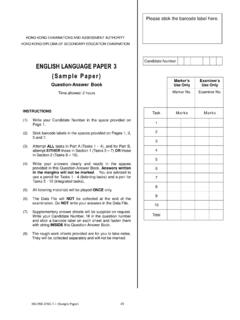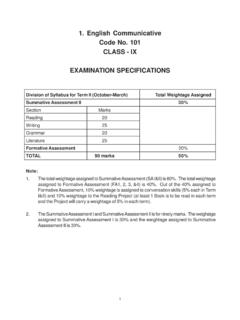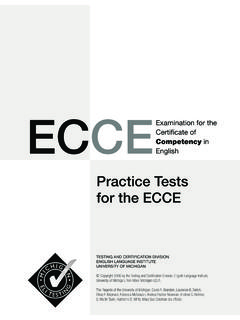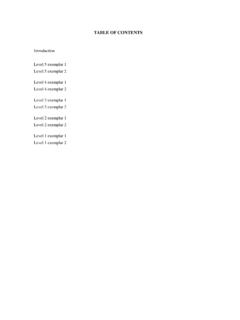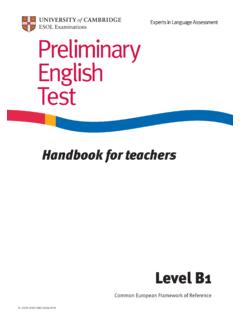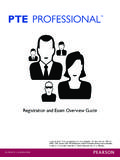Transcription of International Legal English - Lyceum iuris
1 VReadingListeningWriting and SpeakingLanguageUnit 1 The practice of lawpage 8A Bodies of lawB The adversarial and inquisitorial systemsC Types of lawD Types of courtE Persons in courtF Legal LatinA Documents in courtB LawyersC Legal educationD Law-firm structureE Practice areasF Law-firm cultureSpeakingA Explaining what a law saysB Civil-court systemsC Legal educationD Describing a law firmUnit 2 Company law: company formation and managementpage 20A Introduction to company lawB A memorandum of associationC Russian entity formationD Corporate governanceA Company formationB Forming a business in the UKWritingA letter of adviceSpeakingAn informal presentation: a type of company{Key terms: Roles in company management{Language use: Shallandmay{Text analysis: A letter of adviceUnit 2 Language focus page 32 Unit 3 Company law.}}}
2 Capitalisationpage 34A Introduction to company capitalisationB Shareholders and supervisory boardsC New legislation share capital development in BulgariaA A rights issueB Plain languageWritingSummarisingSpeakingParaph rasing and expressing opinions{Key terms: Shares{Language use A: Contrasting information{Language use B: Common collocations (verb plus noun){Text analysis: Understanding legaleseUnit 3 Language focus page 46 Unit 4 Company law: fundamental changes in a companypage 48A Introduction to changes in companiesB Spin-offsC The minutes of a meetingD Shareholder rightsA Explaining Legal aspects of an acquisitionB A checklistWritingStandard phrases for opening and closing letters and emailsSpeakingPresenting a spin-off{Key terms: Opposing concepts in company law{Text analysis: Beginning a presentation{Language use A: Explaining a procedure{Language use B: CollocationsUnit 4 Language focus page 60 Case study 1: Company law page 62 Unit 5 Contracts.}}}}}}}}
3 Contract formationpage 64A Introduction to contract formationB A covenantC Adapting a contract templateA NegotiatingB Contract negotiationWritingA An informative memoB Adapting a contract templateSpeakingA Paraphrasing clausesB Negotiating an agreement{Key terms: Defences to contract formation{Text analysis: Understanding contracts{Language use A: Giving emphasis{Language use B: Negotiating expressions{Language use C: AdverbsUnit 5 Language focus page 76 Unit 6 Contracts: remediespage 78A Introduction to contract remediesB Liquidated damagesC Understanding contract clausesD Types of breachA A Danish remedyB RemediesWritingFollow-up correspondence to a clientSpeakingA Contract remediesB Interviewing a client{Key terms: Types of damages{Language use A: Talking about court actions and rulings{Language use B: Using repetition to aid understanding{Text analysis: Initial interview with a clientUnit 6 Language focus page 90 Case study 2: Environmental law page in this web service Cambridge University PressCambridge University Press978-0-521-27945-1 - International Legal English .}}}}}}}}}
4 A Course for Classroom or Self-study Use, Second EditionAmy Krois-Lindner and TransLegalTable of ContentsMore informationviReadingListeningWriting and SpeakingLanguageUnit 7 Contracts: assignment and third-party rightspage 94A Introduction to contract assignationB Understanding contract clausesC A follow-up emailD A closing argumentE Keeping informedA Preparing a lawsuit and developing an argumentB A closing argumentWritingA memo giving adviceSpeakingA Explaining third-party rightsB Emphatic stressC Discussing and evaluating sources of information{Key terms: Contracts{Language use A: Nouns ending in or and ee{Language use B: Verb + ingform{Text analysis: Persuasive writing and speaking{Language use C: Phrases referring to evidence{Language use D: Informal styleUnit 7 Language focus page 106 Unit 8 Employment lawpage 108A Introduction to employment lawB A sex-discrimination caseC A justified dismissalD Unfair dismissalA An employment tribunal claimB Liability risksWritingA Attachments and formalityB Advising on advantages and disadvantages in an emailSpeakingAgreeing and disagreeing{Key terms: Employment{Language use A: Expressing an opinion, agreeing and disagreeing{Language use B.}}}}}}}}}
5 Participle clauses with ingUnit 8 Language focus page 120 Unit 9 Sale of goodspage 122A Introduction to sale of goods legislationB Retention of titleA Legal writing seminar on drafting clausesB A case briefWriting and SpeakingPresenting a case brief{Key terms: Sale of goods{Language use A: Terms and conditions of sale{Text analysis: A case brief{Language use B: Talking about corresponding laws and institutionsUnit 9 Language focus page 132 Case study 3: Contract law page 134 Unit 10 Real property lawpage 136A Introduction to property lawB A law firm s practice areasC Understanding a lease or tenancy agreementD A case reviewE A reference emailA EasementsB Buying a house in SpainWritingA Describing a firm s practice areasB Summarising and requestingSpeakingA An aspect of real property lawB A case discussion{Key terms: Parties referred to in real property law{Language use A: Contrasting ideas{Language use B: Classifying and distinguishing types or categories{Language use C.}}}}}}}}
6 Giving a presentation structuring and signalling transitionsUnit 10 Language focus page 148 Unit 11 Intellectual propertypage 150A Introduction to intellectual propertyB The State Street caseC Business method patentsD Trade-mark statutesA Training of junior lawyersB Discussing issues copyright and fair useWritingNotes for a case briefWriting and SpeakingParaphrasing in plain languageSpeakingPhrases for discussions{Key terms: Intellectual property{Text analysis: Discourse markers as sentence openersUnit 11 Language focus page 162 Case study 4: Intellectual property law page in this web service Cambridge University PressCambridge University Press978-0-521-27945-1 - International Legal English .}}
7 A Course for Classroom or Self-study Use, Second EditionAmy Krois-Lindner and TransLegalTable of ContentsMore informationviiReadingListeningWriting and SpeakingLanguageUnit 12 Negotiable instrumentspage 166A Introduction to negotiable instrumentsB A promissory noteC Legislation governing electronic negotiable instrumentsA Drafting a promissory noteB Advice from a senior partnerWritingA Summarising requirementsB Providing advice and making suggestionsSpeakingA Describing the Legal situation: usuryB Explaining ideas to a client{Key terms: Negotiable instruments{Language use: Making suggestions and recommendationsUnit 12 Language focus page 176 Unit 13 Secured transactionspage 178A Introduction to secured transactionsB A security agreementC A seminar on revised legislationD An internal emailE An unsettled area of the lawA Creating a security interestB Intellectual property in secured transactionsWritingA polite refusalSpeakingRequesting and presenting information{Key terms: Comparing and contrasting concepts{Language use A: Anticipating events and planning contingencies{Text analysis: Formality / Adverb verb collocations{Language use B.}}}}}}
8 Requesting informationUnit 13 Language focus page 190 Unit 14 Debtor creditorpage 192A Introduction to debtor creditorB Statutes governing attachmentC A career as an insolvency practitionerD Job opportunities in insolvencyE Making a caseA Protecting assets from judicial liensB A job interviewWritingA A covering letterB A thank-you noteSpeakingA Discussing insolvency workB A job interviewC Discussion on restructuring{Key terms: Types of lien{Text analysis: A covering letterUnit 14 Language focus page 204 Case study 5: Transnational insolvency law page 206 Unit 15 Competition lawpage 208A Introduction to competition lawB Anti-competitive activities and antitrust measuresC A cartel case in ChinaD Report on changes in merger regulationA Advising on competition law risksB Merger controlWritingA Using passive constructionsB A proposalC An informative emailSpeakingGiving opinions: a competition-law case{Key terms: Anti-competitive activity{Language use: Warning a client of risks{Text analysis.}}}}}
9 A proposalUnit 15 Language focus page 220 Unit 16 Transnational commercial lawpage 222A Introduction to transnationalcommercial lawB Conflict of laws in private International lawC An article from the CMRA Drafting arbitration clausesB A cross-border disputeWritingA Planning the contents and structure of a letterB Textual transformationSpeakingA short presentation{Key terms: Terms from transnational commercial law{Text analysis: CohesionUnit 16 Language focus page 232 Case study 6: Transnational commercial law page 234 Exam focus page 236 Role cards page 3o1 ILEC practice test page 258 Answer key page 303 Audio transcripts page 278 Index page 331 Acknowledgements page in this web service Cambridge University PressCambridge University Press978-0-521-27945-1 - International Legal English : A Course for Classroom or Self-study Use, Second EditionAmy Krois-Lindner and TransLegalTable of ContentsMore informatio}}


